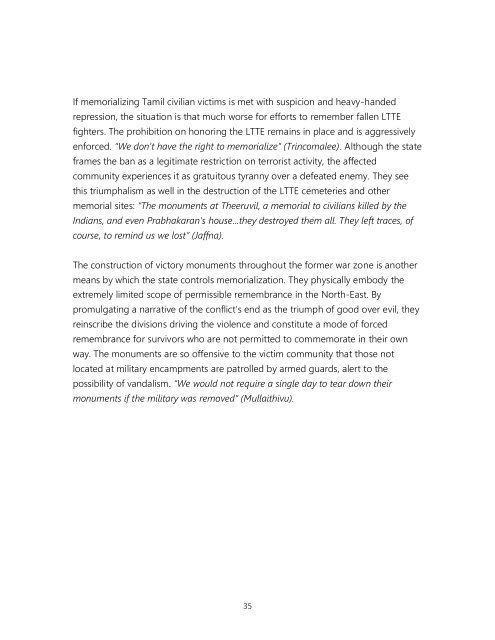7VqrhDjFg
7VqrhDjFg
7VqrhDjFg
You also want an ePaper? Increase the reach of your titles
YUMPU automatically turns print PDFs into web optimized ePapers that Google loves.
If memorializing Tamil civilian victims is met with suspicion and heavy-handed<br />
repression, the situation is that much worse for efforts to remember fallen LTTE<br />
fighters. The prohibition on honoring the LTTE remains in place and is aggressively<br />
enforced. “We don’t have the right to memorialize” (Trincomalee). Although the state<br />
frames the ban as a legitimate restriction on terrorist activity, the affected<br />
community experiences it as gratuitous tyranny over a defeated enemy. They see<br />
this triumphalism as well in the destruction of the LTTE cemeteries and other<br />
memorial sites: “The monuments at Theeruvil, a memorial to civilians killed by the<br />
Indians, and even Prabhakaran's house...they destroyed them all. They left traces, of<br />
course, to remind us we lost” (Jaffna).<br />
The construction of victory monuments throughout the former war zone is another<br />
means by which the state controls memorialization. They physically embody the<br />
extremely limited scope of permissible remembrance in the North-East. By<br />
promulgating a narrative of the conflict’s end as the triumph of good over evil, they<br />
reinscribe the divisions driving the violence and constitute a mode of forced<br />
remembrance for survivors who are not permitted to commemorate in their own<br />
way. The monuments are so offensive to the victim community that those not<br />
located at military encampments are patrolled by armed guards, alert to the<br />
possibility of vandalism. “We would not require a single day to tear down their<br />
monuments if the military was removed” (Mullaithivu).<br />
35


